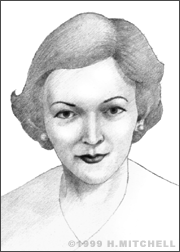Marion Donovan
Like many famous inventors, Marion Donovan (1917-1998) was originally mocked for her most significant invention, but she succeeded in revolutionizing the infant care industry by inventing the disposable diaper.
Born in Fort Wayne, Indiana in 1917, Marion O'Brien grew up surrounded by machinery and invention. Her father and uncle invented the "South Bend lathe," used for grinding automobile gears. After her mother died when she was seven, Marion spent most of her free time in their factory.
O'Brien moved East to attend Rosemont College in the suburbs of Philadelphia. After graduating in 1939 with a BA in English Literature, she took a job as Assistant Beauty Editor at Vogue magazine in New York. Soon she married James Donovan, a leather importer, resigned from her position, started a family, and moved to Westport, Connecticut.
Motherhood gave Donovan good reason to revive the innovative instincts of her own childhood. Like all mothers, Donovan struggled with her babies' exasperating habit of nearly instantaneously wetting her diapers as soon as they were changed – which at that time meant soiled sheets as well. Donovan's first breakthrough, in 1946, was to design a waterproof diaper cover. Steadily working her way through a series of shower curtains, Donovan used her sewing machine to design and perfect a reusable, leakproof diaper cover that did not, like the rubber baby pants of the time, create diaper rash. Donovan called her diaper the "Boater" because it helped babies "stay afloat." The final product was actually made of nylon parachute cloth and featured an additional innovation: Donovan had replaced safety pins with metal and plastic snaps.
The diaper covers' debut came at New York's Saks Fifth Avenue in 1949, where they were, unsurprisingly, an instant success. Donovan's patent was granted in 1951. By that time, Donovan had begun an even more essential innovation: the disposable paper diaper. This was not as easy to create as it may sound, since in order to prevent a rash, a diaper's material must "wick" the moisture away from the baby's skin, rather than absorbing the moisture and retaining it inertly. After much experimentation, Donovan designed a composition of sturdy, absorbent paper that did the job well.
Surprisingly, Donovan did not have instant success with this idea. She toured the major U.S. paper companies and was roundly laughed at for proposing such an unnecessary and impractical item. It took nearly ten years for someone to capitalize on Donovan's idea: namely, Victor Mills, creator of Pampers®.
Meanwhile, Donovan had returned to school. She earned a degree in Architecture at Yale University in 1958. She eventually designed her own house in Greenwich, Connecticut in 1980, but by that time, she had invented numerous practical solutions to problems around the home. For example, Donovan invented a 30-garment compact hanger (the "Big Hangup"); a soap dish that drained into the sink; and the "Zippity-Do," an elastic cord that connected over the shoulder to the zipper on the back of a dress, eliminating the contortionism previously required to put on most women's dress clothes.
Donovan earned over a dozen patents in all. For many years, she also worked as a product development consultant. When she died in 1998, she finally received some of the attention that she deserved. Although Marion Donovan is still not a household name, new parents everywhere have a great deal to thank her for.


